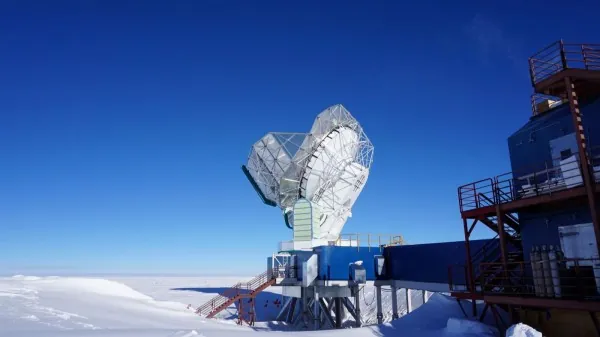
Groundbreaking Discoveries at the South Pole Telescope Illuminate the Birth of Our Universe
2025-01-10
Author: Siti
Introduction
In a monumental leap for cosmology, researchers at the South Pole Telescope (SPT) have unveiled vital new data that reinforces the Big Bang theory and sheds light on a perplexing enigma known as "the Hubble tension."
The Cosmic Microwave Background (CMB)
Approximately 400,000 years post-Big Bang, as the universe began to cool, photons were finally able to break free from an initial turbulent state, bringing forth what we now recognize as the cosmic microwave background (CMB)—the universe's first light. This ancient light has traveled across the cosmos for nearly 14 billion years, carrying with it secrets about the early universe.
Research Collaboration and SPT's Advancements
A prominent team of scientists from the U.S. Department of Energy’s Argonne National Laboratory collaborated on a recent investigation analyzing CMB data acquired from the SPT, located at the National Science Foundation’s Amundsen-Scott South Pole Station in Antarctica. This cutting-edge telescope is equipped with a third-generation camera (SPT-3G) hosting a whopping 16,000 detectors—10 times the capacity of its predecessor—marking a significant advancement in observational cosmology.
Statements from Researchers
Dr. Amy Bender, a physicist at Argonne, expressed her excitement, stating, “Many mysteries remain about the origin and early history of the universe, and this work provides an important step forward in solving them.” The SPT’s high-precision measurements are pivotal for addressing cosmological questions and enhancing our understanding of the cosmos.
Validating the Standard Cosmological Model
The research, spearheaded by the University of California, Davis, focused on validating the standard cosmological model—the framework that describes how the universe has expanded and structured over its lengthy existence. Dr. Lloyd Knox, an esteemed cosmologist at UC Davis, remarked, “We have a largely coherent, detailed, and successful model describing these 14 billion years of evolution.” The findings further support the established tenets of cosmology, showcasing data consistency between polarization and intensity measurements of the CMB.
Utilizing Polarized Light Data
The groundbreaking study utilized polarized light data collected over two years (2019-2020) to create expansive maps of the universe's mass distribution. Polarized light, which oscillates in a specific direction, is an observable trait of CMB photons that have traversed the universe. The researchers meticulously examined the extent of polarization across 1,500 square degrees of the sky.
Gravitational Lensing and its Challenges
One notable phenomenon explored in this research is gravitational lensing, wherein the light rays from distant galaxies are distorted by massive celestial bodies. This distortion complicates the interpretation of CMB images, necessitating advanced computational techniques to isolate gravitational effects. The team enlisted the help of supercomputers at the National Energy Research Scientific Computing Center (NERSC) to enhance their image analyses.
Addressing the Hubble Tension
Crucially, this research tackles the ongoing problem of “the Hubble tension,” which involves discrepancies in measurements of the universe's expansion rate. While one method uses CMB data and the standard cosmological model for predictions, another relies on observational data from stars and supernovae, leading to conflicting expansion rates. The new findings correspond more closely with the predictions from the standard model and CMB intensity methods, presenting further challenges for resolving the Hubble conundrum.
Conclusion
With so much still shrouded in mystery regarding the universe's origin and evolution, these new insights from the South Pole Telescope serve as a powerful reminder of the significance of collaborative scientific research. As Dr. Bender aptly noted, “This work provides an important step forward in solving them,” hinting at the potential for future revelations that may unlock even deeper secrets of our universe.
As we continue to explore these frontiers, one thing is certain: the quest to understand our cosmic past is only just beginning. Stay tuned for more astonishing discoveries that may forever alter our perception of the universe!

 Brasil (PT)
Brasil (PT)
 Canada (EN)
Canada (EN)
 Chile (ES)
Chile (ES)
 Česko (CS)
Česko (CS)
 대한민국 (KO)
대한민국 (KO)
 España (ES)
España (ES)
 France (FR)
France (FR)
 Hong Kong (EN)
Hong Kong (EN)
 Italia (IT)
Italia (IT)
 日本 (JA)
日本 (JA)
 Magyarország (HU)
Magyarország (HU)
 Norge (NO)
Norge (NO)
 Polska (PL)
Polska (PL)
 Schweiz (DE)
Schweiz (DE)
 Singapore (EN)
Singapore (EN)
 Sverige (SV)
Sverige (SV)
 Suomi (FI)
Suomi (FI)
 Türkiye (TR)
Türkiye (TR)
 الإمارات العربية المتحدة (AR)
الإمارات العربية المتحدة (AR)